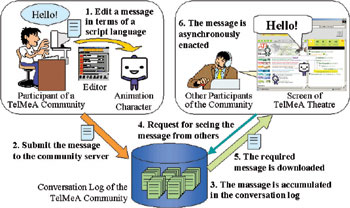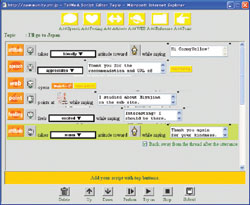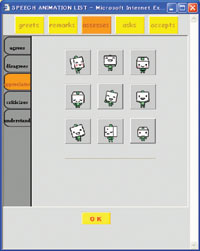1. Introduction
When talking with others, we use all of our natural channels i.e.,
not only spoken words but also embodied expressions such as facial expressions,
gestures, way of speech (speed, loudness, pitch, etc.), pose, gaze,
finger pointing, interpersonal distances, and body touch. By using these
conversation channels, we are not merely exchanging messages and opinions,
but also trying to build a social context, such as interpersonal relationships.
If we can successfully make an adequate social relationship with others,
we can more easily share our intentions and feelings in the social context.
Therefore, brief and logical expressions often do not suffice for everyday
conversations. To accomplish smoother communication and more appealing
presentations, redundant and complex but natural and impressive expressions
made by combining multiple channels are important.
Today's wide spread of information technology increases our chance
of communications in text through, for example, e-mail, Internet forums,
and blogs. However text communication often causes miscommunications.
Because we can use almost no channel other than words in text communication,
we often omit the social context that is necessary to understand each
other, and instead reflect it through superficial impressions or logical
interpretations of the words. As a result, we often get involved in
unsocial and unproductive discussions called "flaming," and
are forced to spend a long time making well-considered sentences to
avoid "flaming." In future development of an advanced information
society, it is very important to consider how to support the social
context of conversation that is lacking in current text communication.
2. Animation Characters as Social Media
It is easy for people to distinguish between media displayed on TV
or a PC and real life. Although they know that media is not a person,
they intuitively tend to behave socially and naturally towards media
in practice [1]. Above all, animation characters are media that make
people behave more socially and naturally because of their human-like
appearance and behaviors [2].
As a result of an experiment that compared conversations mediated
by plain text and animation characters, we found that animation characters
help people identify the senders of the messages [3]. This result indicates
that people can easily interpret each message in a social and familiar
manner as an episode of each animation character. Thus, animation characters
are a type of social media that hold considerable promise for supporting
social and natural online communication.
3. TelMeA Theatre
TelMeA Theatre (Fig. 1) provides an online community service on the
World Wide Web. The main advantage of TelMeA Theatre is its animation
characters, which present the messages of the users. Although the animation
characters of TelMeA Theatre are similar to what is called avatars in
virtual chatting spaces, TelMeA Theatre is more like an Internet forum
than an avatar systems, because the users of TelMeA Theatre do not compose
and post their messages in real time. Fig. 2 shows the conversation
process in TelMeA Theatre. The users can post their messages to the
TelMeA Theatre server and then the messages automatically become available
to all other users. In contrast to Internet forums, the users of TelMeA
Theatre do not compose simple text messages, but combine various types
of expressions, such as inserting spoken lines, adding animated acts,
regulating inter-character distances, opening and citing web pages,
and pointing at images on the web pages, to make the scripts for their
own characters. Fig. 3 shows the script editor window. For example,
if a user pushes the "add speech" button on the top of the
editor, a component with a text area for a speech line and a menu for
selecting its speech type as a verb (like says, asserts, agrees, promises,
etc.) is added (Fig. 4). If a user selects a verb from the menu, a list
of his/her character's animation associated with the verb is shown (Fig.
4). By selecting one from the list, the user can create the character
with animation while saying the speech line with a synthesized voce.
TelMeA Theatre prepares five types of expressions other than "speech":
"feeling", "attitude", "citing web page",
"updating image file", and "pointing at an image."
The users of TelMeA Theatre can combine these types of expressions to
compose their natural and social expressions.
4. TelMeA Theatre Concept
When the "scripts" of the animation characters are made
on the editor, they are sent to the TelMeA Theatre server. Then, they
are formatted in a proprietary XML scheme. One of the benefits of recording
scripts in an XML format is the high availability for content recycling.
In the case of making attractive presentation content or educational
materials designed in the form of a dialogue by multiple characters,
the use of XML format allows TelMeA Theatre to easily prepare templates
of such dialogues or users can easily quote other users' scripts in
their content. In other words, it can recycle character dialog content.
Another benefit of the XML format is the automatic analysis of social
conversations made through various character expressions. Conversation
log data from TelMeA Theatre includes data about the conversation's
structure, that is, for instance, by whom, for whom or for which web
content, how (contents of speech and kinds of character animations),
and with what intention (which can be extracted by the user's selection
of type of speech, feeling, and attitude) it was made. By analyzing
the structure of conversations and quantifying the kinds of intentions
and expressions used in the conversation, we think we can calculate
human relationships and reputations in the community without analyzing
the exact meanings of words. We call this method "Social Summarization
[5]" and are conducting research on the high-quality analysis of
social conversation based on embodied expressions.
5. Conclusions and Future work
Here, I have explained the meaning of animation characters from the
viewpoint of online social communication and an application system called
TelMeA Theatre. TelMeA Theatre has been translated into English and
Dutch. We have a partnership with a venture company to make a business
with TelMeA Theatre as a web application service 1). Furthermore, under
the framework of research collaboration, we were introduced TelMeA Theatre
into several online communities and are collecting practical data. These
communities include KidsPlanet 2), which is administered by a Dutch
internet service provider called the Planet Media Group, and e-Kyoshitsu
3), which is a Japanese e-learning community organized by an NPO of
working high- school teachers and academic researchers. Through the
practice of working with communities and analyzing such data, we aim
to build a theory of the social aspects of communication and contribute
to developing technology that supports the social aspects of human-human
and human-media interactions.
References
| [1] |
Nass, C., & Reeves, B. (1996). The Media Equation. Cambridge:
CSLI Publications, Cambridge University Press. |
| [2] |
Takahashi, T., Takeuchi, Y., & Katagiri, Y. (2000). Change
in Human Behaviours Based on Affiliation Needs - Towards the Design
of Social Guide Agent System, Proc. KES 2000, Vol. 1, pp. 64-67.
|
| [3] |
Takahashi, T., Takeda, H.(2001)TelMeA: TelMeA: Effects of Avatar-like
Agent on Asynchronous Community Systems and the Implementation for
a Web-based System (in Japanese), Journal of Institute of Electronics,
Information and Communication Engineers D-I, Vol. J84-D-I No. 8,
1244-1255. |
| [4] |
Takahashi, T., Katagiri, Y., and Nakao, K., (2003) TelMeA Theatre,
SIGGRAPH2003 Web Graphics Expo. |
| [5] |
Takahashi, T. and Katagiri, Y. (2003). TelMeA2003: Social Summarization
in Online Communities, Proc. CHI 2003, 928-929. |
| [6] |
Takahashi, T., Bartneck, C., Katagiri, Y., Arai N. (2004). TelMeA
- Expressive Avatars in Asynchronous Communications, Int. Journal
of Human-Computer Studies, special issue on subtle expressivity
for characters and robots, Vol. 62, Issue 2, in printing. |
1) http://www.telmea.com
2) http://www.kidsplanet.nl
3) http://www.e-kyoshitsu.org |

Figure 1: Playing
a script for an animation character on TelMeA Theatre

Figure 2: The
conversation process of TelMeA Theatre

Figure 3: Script
editor window for TelMeA Theatre

Figure 4: Animation
list associated with a speech type
|
|


